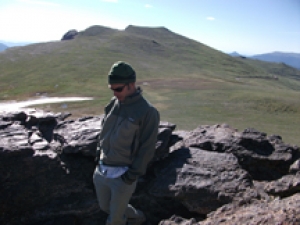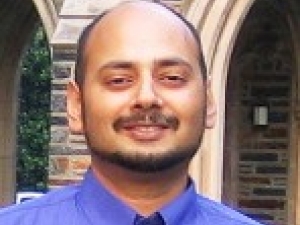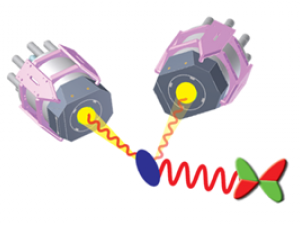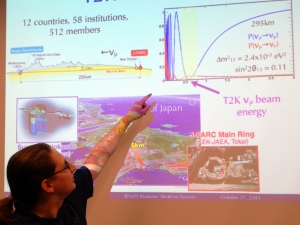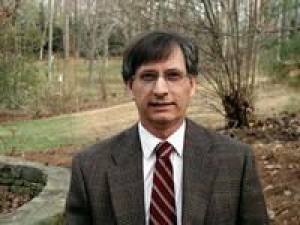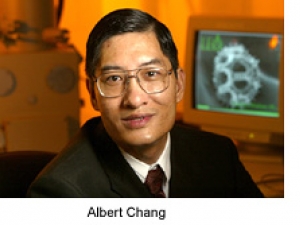Prof. Calvin Howell will chair the committee to search for a new dean of the Graduate School at Duke. Read the article "Howell to Chair Committee Searching for New Graduate School Dean" on Duke Today's website here. This new chair will succeed the late Jo Rae Wright. Read a tribute to Wright in the Chronicle of Higher Education here. read more about Howell to Chair Search Committee for New Grad School Dean »
Prof. Matthew Hastings had a paper published in Science this month. You can read "Universal Signatures of Fractionalized Quantum Critical Points" online here. Hastings was also featured in a Duke Today articles "Electron's Negativity Cut in Half by Supercomputer" as well as the front page of The Chronicle. read more about Hastings' Paper Featured Widely »
Prof. Ashutosh Kotwal's PhD thesis on "Proton and deuteron structure functions in muon scattering at 470-GeV'' is now a "famous paper" according to citation count. Read it here. read more about Kotwal's Thesis Famous »
An undergraduate team of three students, Zongjin Qian, Peter Zhu, and Josh Loyal won a silver medal in the "University Physics Competition," which is described here. read more about Undergrads Receive Silver Medal »
Prof. Robert Behringer was featured in a December 14, 2011 article in Duke Today titled "Stress Causes Clogs in Coffee and Coal." You can read it online here. If you have a subscription to Nature or are on campus you can see the paper here and here. read more about Prof. Behringer Featured in Nature and Duke Today »
Research done by the Theoretical Nuclear and Particle Physics group is currently being featured on the homepage of RENCI, the Rennaissance Computing Institute at UNC. The story contains some nice videos which have been created in collaboration with visualization specialists at UNC. Read the article "Modeling the perfect fluid" here. 1/13/12 Update: A version of this news article has appeared on the International Science Grid This Week (ISGTW) site. You can read it here. read more about Theoretical Physics Research on RENCI Site »
The electron neutrino appearance results from the Tokai-to-Kamioka experiment reported in June have been selected as one of the top 10 breakthroughs in physics by Physics World magazine. Read the story here. read more about T2K Oscillation Results Chosen in the Top 10 Physics Breakthroughs of 2011 »
Every year the graduate school uses various types of endowments to give out fellowships to outstanding graduate students. These fellowships are both merit and need based. This year four graduate students from the physics department were nominated by the Director of Graduate Studies (DGS) based on requests from the faculty and students. Three students (Meg Shea, Kyle Kalutkawiecz and Chris Varghese) were nominated for summer fellowships that provides funds to cover tuition… read more about Physics Graduate Students Win Duke Fellowships »
Submitted by Prof. Werner Tornow After discovering reactor neutrino oscillations, determining the heat produced by radioactive decays in the interior of the Earth, determining the extraterrestrial high-energy anti-neutrino flux on Earth, and studying solar neutrinos with the KamLAND detector, on October 12, 2011 a subgroup of the original Japanese-US KamLAND collaboration commenced its search for the zero-neutrino double-beta decay of 136Xe. For this purpose, a 3.4 m diameter nylon balloon filled with about 400 kg… read more about KamLAND-Zen Started Zero-Neutrino Double-Beta Decay Search »
TUNL's instrumentation development work done in collaboration with the detector group at Jefferson Laboratory was recently featured in the DOE Pulse. The DOE Pulse is an online newsletter that highlights science and technology at DOE National Laboratories. You can read the story online here. read more about Duke-JLab Plant Instrumentation R&D featured on DOE Pulse »
Alumni Seth Henshaw ('10) and his Duke colleagues in TUNL Profs. Henry Weller and Mohammad Ahmed's recent Physics Review Letter 107, 222501 (2011): A New Method for Precise Determination of the Isovector Quadrupole Resonances in Nuclei (Henshaw, Ahmed, Feldman, Nathan, Weller) has been highlighted by the APS. Read the synopsis "Ringing Nuclear Resonances" here. One more demonstration of the power of the beams at HIGS! read more about New HIGS Result Spotlighted by APS »
Nasser Demir earned his Ph.D in 2010 working with Prof. Steffen A. Bass. During the 2010-2011 academic year he was an Instructor in the Physics Department involved with teaching Physics 54 and Physics 62. Dr. Demir has recently officially been appointed as Assistant Professor in the Physics Department at Kuwait University, where he has been teaching since September 2011. He shall join the Theoretical Physics group at Kuwait University as the third nuclear theorist. See his Kuwait University… read more about Nasser Demir Appointed as Assistant Professor of Physics at Kuwait University »
The Southeastern Section of the American Physical Society (SESAPS) annual meeting (SESAPS 2011) was held Oct. 19-22 in Roanoke, VA. The meeting was hosted by Virginia Tech and over 295 people attended. Prof. Roxanne Springer was the chair of the program committee as part of her duties as Chair-Elect of SESAPS. The conference was held at an historic hotel, now called the Hotel Roanoke and Conference Center, which is listed in the National Register of Historic Places as a favorite 19th and early 20th… read more about Duke Physics at SESAPS 2011 »
Prof. Stefano Curtarolo and Shidong Wang, a postdoc in Curtarolo's lab, have a paper in the journal Physics Review X about a new materials "cookbook" they have compiled. The cookbook contains information to help scientists and engineers combine elements to create thermoelectric devices. "We have calculated the thermoelectric properties of more than 2,500 compounds and have calculated all their energy potentials in order to come up with the best candidates for combining them in the most efficient ways, "… read more about Prof. Curtarolo and Postdoc Compiled "Cookbook" »
The Duke Teaching Observatory was established in the fall of 2002 with funds from Provost of Arts and Sciences and the Physics Department. The Observatory is located in a clearing in the Duke Forest about 4.5 miles from West Campus. The observatory is an important part of the student experience in Physics 55 (Introductory Astronomy). Students visit the observatory three times each over the course of the semester, allowing small group work in which 3-4 students operate a telescope. Over the course of the term, students… read more about Ten Years Under the Stars »
When in need of a custom-designed tissue press, a mouse-exposure chamber, an umbilical cord blood collector, photoelastic disks, or almost any other apparatus made of metal or plastic, those in the know turn to the Duke Physics Instrument Shop. “We do all types of plastic and metals works,” says manager Bernie Jelinek. “We do welding, brazing, silver soldering, and a little bit of sheet metal. We do all types of machining—milling, turning, grinding.” The Instrument Shop, located on the bottom floor of the… read more about Two Great Places for Making Just About Anything: The Duke Physics Instrument Shop and the Staff Machine Shop »
This year marks the 100th anniversary of Ernest Rutherford's discovery of the atomic nucleus using alpha-particle scattering experiments. The event was celebrated at CERN in Switzerland on November 15 by an afternoon colloquium, which was webcast live worldwide. The full program of talks can be found here. Prof. Mark Kruse of Duke Physics closed the event with a talk on how Rutherford has inspired young physicists from New Zealand, where Rutherford was born, grew up and was… read more about Prof. Kruse Gives Invited Talk at Rutherford Centennial Colloquium at CERN, Geneva »
Submitted by Prof. Calvin Howell - The Triangle Universities Nuclear Laboratory (TUNL) is involved with activities associated with the Nuclear Science Merit Badge of the Boy Scouts of America. As part of this outreach to young people, TUNL offers science presentations, hands-on activities and tours of the research facilities that are appropriate for a wide age range (7th grade through high school students). This fall (September 10, 2011) Boy Scout Troop 101 from Asheville, NC visited TUNL as part of their… read more about TUNL Outreach Activities Update »
On November 2, about fifty people attended the Physics Department's first Music Recital, which provided an opportunity for students, staff, faculty, and friends of the Physics Department to perform a variety of pieces spanning classical music to folk music to electronic music to jazz. The recital was organized by Prof. Henry Greenside, who in talking with many students as the Director of Undergraduate Studies and with many physics colleagues realized that there were many talented and enthusiastic musicians… read more about Physics Department Holds First Music Recital »
Prof. Arlie Petters (primary appointment: Mathematics) was featured on Duke Research Blog in a story by Ashley Yeager "Prescription lens brings spinning black holes into focus." You can read the story by clicking here. read more about Petters Featured on Duke Research Blog »
NOTE: SOME LINKS HAVE BECOME BROKEN DUE TO WEBSITE REDESIGN Graduate student Yingyi Zhang has won the People’s Choice Award in the 2011 Mahato Memorial Event Photo Contest sponsored by the Pratt School of Engineering and the Duke Graduate School. Zhang’s photo shows the red fluorescent light emitted by a cloud of atoms cooled nearly to absolute zero. The Mahato contest, “Envisioning the Invisible,” was established to honor the memory of Abhijit Mahato, an engineering student at Duke who was murdered in… read more about Graduate Student Yingyi Zhang Wins Award in Mahato Photo Contest »
In September, graduate student Abhiji Mehta travelled to Lausanne, Switzerland to attend a workshop on Continuum Quantum Monte Carlo (QMC) Methods sponsored by CECAM (the Centre européen de calcul atomique et moléculaire) at the École Polytechnique Fédérale de Lausanne. His travel was supported by an NSF travel grant from the Materials Computation Center at UIUC and by CECAM. At this workshop, Mehta was able to meet QMC experts and learn about several techniques that he can apply to his research.… read more about Grad student Mehta travels to Switzerland for conference, visit to CERN »
Prof. Patrick Charbonneau has a new paper in Physical Review Letters titled "Glass Transition and Random Close Packing above Three Dimensions." Click here to read the abstract. Click here to read an article on the Duke Research website about Charbonneau's paper. read more about Prof. Charbonneau published in Physical Review Letters »
At right: Will Sager on the R/V Marcus G. Langseth research ship with Honolulu in the background, just before heading out to Shatsky Rise in the Pacific, July 2010. When Will Sager was majoring in physics at Duke, he wanted to go into astronomy, but an intro geology course opened up a new vista. “I took Geo 101 at Duke and it was really interesting,” Sager says. “The professor said to me, ‘You ought to consider geophysics,’ and I said, ‘What’s that?’” Today, Sager is a… read more about Alum Uses Remote Sensing to Make Sense of Ocean Basins »
John Thomas, Fritz London Professor Emeritus, has won the Jesse W. Beams Award, given by the Southeastern Section of the American Physical Society for significant and meritorious research. The award was presented on October 21, 2011, at the conference banquet of the 78th Annual Meeting of SESAPS in Roanoke, Virginia. “It’s very exciting,” Thomas says, explaining that he was told that he won the award “for a combination of broad contributions to optical, molecular and atomic physics as well as my current… read more about Prof. Thomas Wins Beams Award »
Zeng with the CDF DetectorProf. Ashutosh Kotwal's graduate student, Yu Zeng, has received the Universities Research Association's Visiting Scholarship for his research on the CDF experiment at Fermilab. He is pursuing the world's most precise measurement of the W boson mass. This measurement will provide a stringent test of the Higgs mechanism in the Standard Model of particle physics, even as the direct search for the Higgs boson is ongoing at LHC and Fermilab. read more about Grad Student Zeng Receives Visiting Scholarship »
The Tevatron proton-antiproton collider at Fermilab was shut down on September 30. The experiments recording the collision data, CDF and D-zero ceased operation after more than twenty years of producing results that have significantly advanced our understanding of the universe. Chen Zhou, a Duke second-year graduate student, spent the summer at the CDF experiment, funded by a Fermilab University Research Association fellowship. Chen was trained to be one of the expert operators of the CDF experiment, which… read more about Grad Student Zhou, One of Last Physicists at Controls of CDF Experiment »
In September Visiting Assistant Professor Hannah Petersen was selected by the Helmholtz Association in Germany to lead a Young Investigator Group. This program offers the possibility to young scientists within 2-6 years after having received their PhD degree to build their own research group. The funding over a 5-year period consists of a total sum of 1.25 million Euro (approximately $1.7M). The selection process is highly competitive. The candidates have to go through three rounds of interviews with… read more about Hannah Petersen Selected for Helmholtz Young Investigator program »
Prof. Albert Chang's work was featured in the Duke Today article "Scientists Observe How Superconducting Nanowires Lose Resistance-Free State." Click here to read the story. read more about Prof. Chang Featured in Duke Today »
At right: PhD student Abe Clark in the Behringer Lab During this past summer, five students, including a Duke undergraduate and four students from local high schools, worked in the Behringer Lab in the Department of Physics at Duke. Each student had an independent project, and was teamed with either Duke post-doc, Joshua Dijksman, or Duke Ph.D. student, Abe Clark. Colton Brown, a Duke Physics major, worked with Abe Clark on several projects. He… read more about Update on Students' Work in Behringer Lab »


